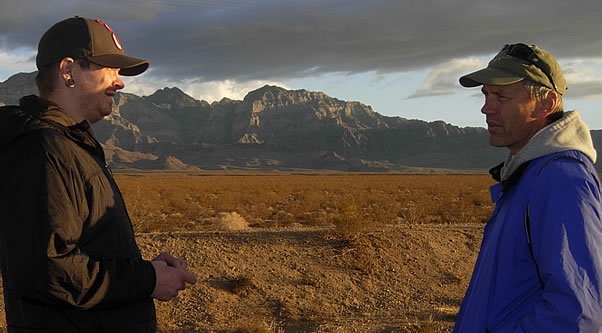Balanced Approach to Energy Renewal
Biologist Warns Against Heedless Renewable Energy Building
June 29, 2010
By Russ L. Hudson
Rushing into building massive solar and wind farms in the Mojave Desert might sound like a good idea to help build renewable energy, but biologist Darren Sandquist warns that there could be serious consequences.
Sandquist is acutely aware of ecological scars caused by rushing into things. He has studied the effects of human alterations for more than five years as part of the U.S. Geological Survey’s Recovery and Vulnerability of the Desert Ecosystems project.
For example, without care, the 4,500-acre solar farm near Victorville, proposed by Stirling Energy Systems in 2005, could have caused as much damage as a big oil field. If built, it would have been the world’s largest solar farm and provided electricity for 200,000-plus homes, but it would have covered 4,500 acres — the same size as Yosemite Valley. To feed the energy needed for Orange County’s three million people, at least three such solar farms would have to be built, covering the same size land mass as the city of Huntington Beach.
Renewable energy sources are necessary, Sandquist says, but to do so, a balanced approach is equally important. Recently, he explained how this can be done.
Q: Are you opposed to solar and wind farms?
Not at all, they can be better for us overall. I know there will be some damage to the environment, but that trade-off would be more acceptable if we first understand what the potential damage could be.
Q: Why is that important?
So solutions can be sought before problems arise.
For example, if you don’t know dust would be a big a problem, you won’t think of prevention. Dust from the Mojave could reach beyond L.A. or Las Vegas. It would land on the snow pack, darkening it so it melts faster. It would settle on drinking water reservoirs and get into machinery. It would cause allergic reactions. It would coat leaves so they photosynthesize less and coat solar cells, reducing electricity production. Washing them takes thousands of gallons for a large farm and more water for solar cells downwind. Water is already scarce.
Q: How could solar or wind farms cause that much dust?
Facility and road construction would break the desert’s biological crust, a thin matrix of lichen, mosses and fungi. The crust holds dust down. Once broken, wind and water erode it more. Without the crust, rainfall evaporates too fast, killing plants, which causes more erosion. The damage continues even after construction is finished.
Q: What can be done about that?
I don't know, exactly. That’s for the engineers and decision makers to solve once we have information.
For example, research might show it’s better not to build roads to seldom-visited areas. It might be better to drive over the landscape and let it heal afterward, and engineers might develop a vehicle that causes the least damage. We might arrange windmills like a canopied forest, with tall ones, shorter ones, and ‘egg beater-shape’ ones lowest. That denser packing would require fewer roads.
I like the idea of solar panels on rooftops, like using the warehouses you see when flying into Ontario. The downside is linking them, but upsides are no more land taken, no dust, no new roads, no miles of transmission lines. New technologies are arriving all the time. We just have to investigate what works best for us before we rev up bulldozers.
Related Story:
Survival of the Fittest or Extinction by Human Progress?


